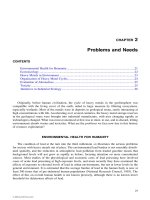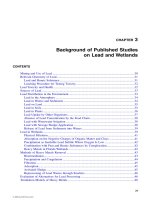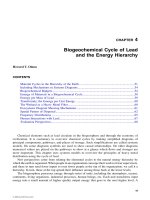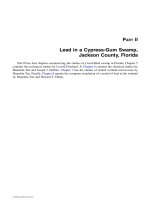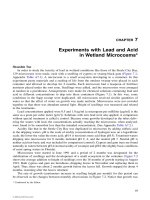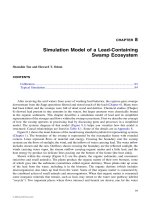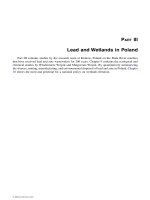Heavy metals in the environment origin, interaction and remediation, volume 6
Bạn đang xem bản rút gọn của tài liệu. Xem và tải ngay bản đầy đủ của tài liệu tại đây (23.88 MB, 283 trang )
Tai Lieu Chat Luong
Heavy Metals in the Environment
INTERFACE SCIENCE AND TECHNOLOGY
Series Editor: ARTHUR HUBBARD
In this series:
Vol. 1: Clay Surfaces: Fundamentals and Applications
Edited by F. Wypych and K.G. Satyanarayana
Vol. 2: Electrokinetics in Microfluidics
By Dongqing Li
Vol. 3: Radiotracer Studies of Interfaces
Edited by G. Horányi
Vol. 4: Emulsions: Structure Stability and Interactions
Edited by D.N. Petsev
Vol. 5: Inhaled Particles
By Chiu-sen Wang
Vol. 6: Heavy Metals in the Environment
Edited by H.B. Bradl
INTERFACE SCIENCE AND TECHNOLOGY - VOLUME 6
Heavy Metals in the Environment
Edited by
H.B. Bradl
University of Applied Sciences Trier
Neubrucke, Germany
2005
ELSEVIER
ACADEMIC
PRESS
Amsterdam - Boston - Heidelberg - London - New York - Oxford - Paris
San Diego - San Francisco - Singapore - Sydney - Tokyo
ELSEVIERB.V.
Radarweg 29
P.O. Box 211, 1000 AE Amsterdam
The Netherlands
ELSEVIER Inc.
525 B Street, Suite 1900
San Diego, CA 92101-4495
USA
ELSEVIER Ltd
The Boulevard, Langford Lane
Kidlington, Oxford OX5 1GB
UK
ELSEVIER Ltd
84 Theobalds Road
London WC1X 8RR
UK
© 2005 Elsevier Ltd. All rights reserved.
This work is protected under copyright by Elsevier Ltd., and the following terms and conditions apply to its use:
Photocopying
Single photocopies of single chapters may be made for personal use as allowed by national copyright laws. Permission of the
Publisher and payment of a fee is required for all other photocopying, including multiple or systematic copying, copying for
advertising or promotional purposes, resale, and all forms of document delivery. Special rates are available for educational
institutions that wish to make photocopies for non-profit educational classroom use.
Permissions may be sought directly from Elsevier's Rights Department in Oxford, UK: phone (+44) 1865 843830, fax (+44)
1865 853333, e-mail: Requests may also be completed on-line via the Elsevier homepage
( />In the USA, users may clear permissions and make payments through the Copyright Clearance Center, Inc., 222 Rosewood
Drive, Danvers, MA 01923, USA; phone: (+1) (978) 7508400, fax: (+1) (978) 7504744, and in the UK through the Copyright
Licensing Agency Rapid Clearance Service (CLARCS), 90 Tottenham Court Road, London W1P 0LP, UK; phone: (+44)
20 7631 5555; fax: (+44) 20 7631 5500. Other countries may have a local reprographic rights agency for payments.
Derivative Works
Tables of contents may be reproduced for internal circulation, but permission of the Publisher is required for external resale or
distribution of such material. Permission of the Publisher is required for all other derivative works, including compilations and
translations.
Electronic Storage or Usage
Permission of the Publisher is required to store or use electronically any material contained in this work, including any chapter
or part of a chapter.
Except as outlined above, no part of this work may be reproduced, stored in a retrieval system or transmitted in any form or by
any means, electronic, mechanical, photocopying, recording or otherwise, without prior written permission of the Publisher.
Address permissions requests to: Elsevier's Rights Department, at the fax and e-mail addresses noted above.
Notice
No responsibility is assumed by the Publisher for any injury and/or damage to persons or property as a matter of products liability,
negligence or otherwise, or from any use or operation of any methods, products, instructions or ideas contained in the material
herein. Because of rapid advances in the medical sciences, in particular, independent verification of diagnoses and drug dosages
should be made.
First edition 2005
Library of Congress Cataloging in Publication Data
A catalog record is available from the Library of Congress.
British Library Cataloguing in Publication Data
A catalogue record is available from the British Library.
ISBN: 0-12-088381-3
ISSN: 1573-4285 (Series)
@ The paper used in this publication meets the requirements of ANSI/NISO Z39.48-1992 (Permanence of Paper).
Printed in The Netherlands.
V
Preface
Heavy metals in the environment pose a variety of very interesting scientific
questions. The fields of work involved cover a wide range of disciplines. Thus,
heavy metals are a good example for an interdisciplinary field of work ranging
from geology, mineralogy, and geochemistry, if their origin and natural
occurrence is concerned, to analytical, physical, and colloid chemistry, when it
comes to detection of heavy metals and their interactions with environmental
media such as water, groundwater, soil, rock, and air, and biology, ecology,
ecotoxicology, and medicine, if one is concerned with their impact on global
ecosystems and their effects on human and animal health. Finally, the
remediation of heavy metals requires cooperation of several engineering
disciplines such as environmental, chemical, and civil engineering.
Of course it is not possible to cover this wide range in sufficient depth in
one single book alone. Nevertheless this book aims at giving an overview on the
most important topics for the reader interested in the subject. Although this book
is not meant to be an introductory textbook, pain was taken to keep the text to a
level, which allows graduate students to read and understand it. The first chapter
gives some ideas on both natural and anthropogenic sources of heavy metals in
the environment. The second chapter introduces analytical methods for their
detection, the most important biogeochemical processes regulating their
mobility, and their ecotoxicological effects on plants, animals, and humans. In
this chapter, detailed information over the behaviour of some selected heavy
metals is given as well. The third chapter gives an overview over different
strategies for the remediation of heavy metals. In this context, innovative new
strategies for the remediation of soil and groundwater contaminated with heavy
metals such as permeable reactive barriers are discussed along with approved
technologies such as encapsulation, soil washing, solidification, and
phytoremediation.
There have been many sources of support during the work on this book.
First I would like to thank my contributors, who took pain, work, and patience in
vi
Preface
preparing their subchapters. Prof. Dr. Doris Stiiben, University of Karlsruhe,
Germany, gives an overview over Platinum Group Metals. Prof. Dr. Chris Kim,
Chapman University, Orange, CA, USA, prepared the subchapter on sorption of
heavy metals. Dr. Utz Kramar, University of Karlsruhe, Germany, introduces
analytical methods for their detection, and last but not least, Dr. Anthimos
Xenidis, National Technical University of Athens, Greece, wrote a subchapter
on stabilization and solidification. Their time and effort is greatly appreciated.
Parts of this book were prepared during a sabbatical leave at the Environmental
Research Centre, University of Karlsruhe, Germany. I would like to express my
thanks to all the colleagues there for never-ending support and a good time.
Finally, I would like to thank my colleagues and students at the UmweltCampus, Birkenfeld, for their help and patience during the work on this book.
Heike B. Bradl
Birkenfeld
November, 2004
vii
Table of Contents
Preface
V
CHAPTER 1: SOURCES AND ORIGINS OF HEAVY METALS
1. Introduction
1
2. Heavy Metals in Rocks and Soils
2.1. Magmatic Rocks
2.2. Sedimentary Rocks
2.3. Metamorphic Rocks
2.4. Soil Formation
2.4.1. Organic Material
2.4.2. Clay Minerals
2.4.3. Oxides and Hydroxides
1
1
4
5
6
7
8
11
3. Heavy Metals in Water and Groundwater
3.1. Surface Waters
3.2. Groundwater
12
12
12
4. Heavy Metals in the Atmosphere
15
5. Anthropogenic Sources of Heavy Metals
5.1. Agricultural Activities
5.1.1. Phosphatic Fertilizers
5.1.2. Pesticides
5.1.3. Sewage Effluents
5.1.4.Biosolids
5.2. Industrial Activities
5.2.1. Mining
5.2.2. Coal and Petroleum Combustion
5.2.3. Indoor and Urban Environments
5.2.4. Solid Waste Disposal
17
18
18
19
19
21
22
22
23
23
25
References
25
viii
Table of Contents
CHAPTER 2: INTERACTION OF HEAVY METALS
1. Analytical Procedures for the Detection of Heavy Metals (U. Kramar)
28
1.1. Sample Preparation
28
1.1.1. Soils and Sediments
29
1.1.2. Vegetation
29
1.1.3. Waters
29
30
1.2. Digestion Methods
1.2.1. Soils, Sediments, and Building Materials
30
1.2.2. Vegetation
32
32
1.3. Analytical Methods
1.3.1. Optical Spectroscopic Methods
32
1.3.2. Microanalytical Methods
45
2. Biogeochemical Processes regulating Heavy Metal Mobility
46
2.1. Sorption (C.Kim)
47
2.1.1. Introduction
47
2.1.2. Adsorption Mechanisms
48
2.1.3. Utility of X-Ray Absorption Spectroscopy in Determining Sorption
56
Mechanisms
2.1.4. Model Approaches for Heavy Metal Sorption (H.B. Bradl)
59
2.1.5. Geochemical Parameters influencing Adsorption
73
2.2. Redox Reactions
76
2.3. Weathering
77
2.4. Driving Factors
77
2.4.1. pH and Redox Potential
77
2.4.2. Complexing Agents
78
2.4.3. Type and Chemical Speciation of Metal
83
3. Ecotoxicological Effects of Heavy Metals
3.1. Pathways of Heavy Metal Access
3.1.1. Respiration
3.1.2. Water
3.1.3. Food
3.2. Bioavailability and Bioaccumulation
3.2.1. Definition
3.2.2. Bioavailability in the Soil-Plant System
3.2.3. Bioavailability in the Aquatic System
85
85
85
86
86
87
87
90
91
4. Individual Behaviour of Selected Heavy Metals
4.1. Arsenic
4.1.1. Chemical and Physical Character of Arsenic
4.1.2. Sources and Applications of Arsenic
4.1.3. Ecotoxicological Effects of Arsenic
93
93
93
94
96
Table of Contents
4.2. Cadmium
4.2.1. Chemical and Physical Character of Cadmium
4.2.2. Sources and Applications of Cadmium
4.2.3. Ecotoxicological Effects of Cadmium
4.3 Chromium
4.3.1. Chemical and Physical Character of Chromium
4.3.2. Sources and Applications of Chromium
4.3.3. Ecotoxicological Effects of Chromium
4.4. Copper
4.4.1. Chemical and Physical Character of Copper
4.4.2. Sources and Applications of Copper
4.4.3 Ecotoxicological Effects of Copper
4.5. Lead
4.5.1. Chemical and Physical Character of Lead
4.5.2. Sources and Applications of Lead
4.5.3. Ecotoxicological Effects of Lead
4.6. Manganese
4.6.1. Chemical and Physical Character of Manganese
4.6.2. Sources and Applications of Manganese
4.6.3. Ecotoxicological Effects of Manganese
4.7. Mercury
4.7.1. Chemical and Physical Character of Mercury
4.7.2. Sources and Applications of Mercury
4.7.3. Ecotoxicological Effects of Mercury
4.8. Molybdenum
4.8.1. Chemical and Physical Character of Molybdenum
4.8.2. Sources and Applications of Molybdenum
4.8.3. Ecotoxicological Effects of Molybdenum
4.9. Nickel
4.9.1. Chemical and Physical Character of Nickel
4.9.2. Sources and Applications of Nickel
4.9.3. Ecotoxicological Effects of Nickel
4.10. Platinum Group Elements PGE (D. Stiiben)
4.10.1. Introduction
4.10.2. Chemical and Physical Character of PGE
4.10.3. Sources and Applications of PGE
4.10.4. PGE Emission by Car Catalytic Converters
4.10.5. PGE in Environmental Matrices
4.10.6. Transformation of PGE and Bioaccumulation
in the Environment
4.11. Zinc (RB.Bradl)
4.11.1. Chemical and Physical Character of Zinc
4.11.2. Sources and Applications of Zinc
4.11.3. Ecotoxicological Effects of Zinc
ix
98
98
101
103
104
104
106
107
108
108
110
Ill
Ill
Ill
114
115
115
115
117
118
119
119
121
122
124
124
125
126
126
126
127
128
128
128
129
131
134
135
137
139
139
141
142
X
Table of Contents
4.12. Other Heavy Metals
4.12.1. Cobalt
4.12.2. Silver
4.12.3. Thallium
4.12.4. Tin
143
143
144
146
147
References
148
CHAPTER 3: REMEDIATION TECHNIQUES
1. Introduction
165
2. Physical Remediation Techniques
2.1. Soil Washing
2.1.1. Particle-Size Dependent Distribution of Pollutants
2.1.2. Wet Liberation
2.1.3. Classification of Fine Particles
2.2. Encapsulation
2.2.1. Slurry Walls
2.2.2. Thin Walls
2.2.3. Sheet Pile Walls
2.2.4. Bored-pile Walls and Jet Grouting
2.2.5. Injection Walls
2.2.6. Artificial Ground Freezing and Frozen Walls
2.3. Vitrification
2.4. Electro kinetic Techniques
2.4.1. Principle Electrokinetic Transport Processes
2.4.2. Electrode Reactions
2.4.3. Applications
2.5. Permeable Reactive Barrier Systems
2.5.1. Permeable Walls
2.5.2. Funnel and Gate Systems
2.5.3. Reactor Technologies for Removal of Heavy Metals
2.5.4. Engineering Methods for Execution of
Permeable Reactive Barriers
165
165
167
168
169
170
170
171
172
172
172
173
174
176
177
178
179
179
180
182
183
3. Chemical Remediation Techniques
3.1. Precipitation
3.2. Ion Exchange
3.3.FloccuIation
3.3.1. Colloidal Systems
3.3.2. Flocculation Chemicals
3.4. Membrane Filter Processes
3.5. Solidification/Stabilization (A. Xenidis)
191
192
193
194
194
197
198
200
186
Table of Contents
3.5.1. Introduction
3.5.2. Solidification/Stabilisation Mechanisms
3.5.3. Evaluation of Solidification/Stabilisation Processes
3.5.4. Technology Description
3.5.5. Field Applications
xi
200
202
209
216
230
4. Phytoremediation of Heavy Metals (H.B. Bradl)
4.1. Introduction
4.2. Basic Physiological Processes
4.2.1. Processes involving Microorganisms
4.2.2. Plant Processes
4.3. Mechanisms of Phytoremediation
4.3.1. Phytoextraction
4.3.2.Phytostabilization
4.3.3. Phytovolatilization
4.3.4. Phytofiltration
4.4. Advantages and Limitations of Phytoremediation
235
236
236
237
239
241
241
245
247
248
249
References
251
Index
263
This Page Intentionally Left Blank
Heavy Metals in the Environment
H.B. Bradl (editor)
© 2005 Elsevier Ltd. All rights reserved.
Chapter 1
Sources and Origins of Heavy Metals
H.B.Bradl3
"Department of Environmental Engineering, University of Applied Sciences Trier, Umwelt-Campus Birkenfeld, P.O. Box 301380,55761 Birkenfeld, Germany
1. INTRODUCTION
There are different sources for heavy metals in the environment. These
sources can be both of natural or anthropogenic origin. This chapter gives a
general introduction into the different heavy metal sources such as magmatic, sedimentary, and metamorphic rocks, weathering and soil formation,
the rock cycle, the origin of heavy metals in surface and groundwater as
well as in the atmosphere, and anthropogenic sources stemming from human activities such as industrial production and agriculture [1,2].
2. HEAVY METALS IN ROCKS AND SOILS
2.1. Magmatic Rocks
Rocks and soils are the principal natural sources of heavy metals in
the environment. The primary rocks, which are called magmatic or igneous
rocks, crystallize from magma upon cooling down. Magma is defined as
molten rock material originating from the earth's mantle, which can be
transported to the surface by several geological processes such as volcanism or plate tectonics [3]. Magma contains a large variety of different
chemical elements. Heavy metals are incorporated as trace elements into
the crystal lattice of the primary minerals, which form during the cooling of
the magma. This process is called isomorphic substitution, as the heavy
metals substitute other atoms during the crystallization. The amount of
isomorphic substitution is determined by the ion radius, the ion charge, and
the electronegativity of the main element and of the substituting element.
The trace elements occurring in the most common rock forming minerals
are given in Table 1.
2
H.B. Bradl
Table 1
Trace elements of the most common rock forming minerals
Mineral
Re sistance to Weathering
Trace Eleme nt
Olivine
Ni, Co, Mn, Li, Zn, Cu, Mo
weathers easily
Hornblende
Ni, Co, Mn,Se, Li, V, Zn, Cu, Ga
Augite
Ni, Co, Mn, Se, Li, V, Zn, Pb, Cu, Ga
Biotite
Rb,Ba,. Ni. Co. Mn.Se.Li.V. Zn. Cu. Ga
Rare earth elements, Pb, Sr
Apatite
Sr, Cu, Ga, Mn
Anorthite
Sr, Cu, Ga, Mn
Andesine
Cu, Ga
Oligoclase
Cu, Ga
Albite
intermediate stability
Garnet
Mn, Cr , Ga
Orthoclase
Rb,Ga , Sr, Cu, Ga
Muscovite
F,Rb,l Ba, Sr, Cu, Ga, V
Rare earth elements, V, Sn
Titanite
Co, Ni, Cr,V
Ilmenite
Zn, Co , Ni, Cr, V
Magnetite
Turmaline
Li, F, Ga
Zircon
Hf,U
resistant
Quartz
Modified after Ref. 4.
Magmatic rocks can be classified by their chemical composition on
the one hand and their crystal size and texture on the other hand. If magma
cools down slowly within the earth's crust, there is enough time for large
crystals to be formed, which can easily be recognized with the naked eye. If
magma is extruded rapidly onto the earth's surface (e.g. by volcanic activity), crystallization occurs quickly, and consequently, those magmatic rocks
are characterized by very fine crystals that can not be seen with the naked
eye. Magmatic rocks showing large crystals are called intrusive rocks or
intrusiva, while those with fine texture and small crystals are called effusive rocks or effusiva. The principal effusive and intrusive magmatic rocks
and their mineral and chemical components are identified in Fig. 1. For
each individual intrusive rock, there is an equivalent effusive counterpart,
which is identical in chemical composition, yet shows different crystal size
and texture (e.g. granite and rhyolithe). During the crystallization phase of
a magma body, a process called chemical differentiation takes place. Mineral crystallization is a function of both temperature and pressure conditions, which change constantly during cooling. Different minerals precipitate according to their stability fields at limited ranges of temperature, pressure, and chemical composition conditions.
Sources and Origins of Heavy Metals
3
Fig. 1. General classification of magmatic rocks (effusiva and intrusiva) showing principal minerals and their chemical composition.
The magma is depleted of those elements, which have been bound into
the crystallizing minerals, while is at the same time enriched in those elements that have not been incorporated into those minerals. Consequently,
the chemical composition of the magma body is subject to changes during
the cooling down process. Most heavy metals concentrate mainly in the
residual magma. Only a few heavy metals form their own mineral or form
an important component of a principal mineral.
One example is Cr, which crystallizes as the mineral chromite
(FeCr2O4), or Ni, which occurs in the mineral forsterite (Mg2[Ni]SiO4) as a
substitute for Mg. In the later stages of differentiation, metal concentrations
increase, which may lead to the precipitation as their own mineral (e.g. U
as uranitite, Be as beryl) or their incorporation into late-stage forming accessory mineral. One example is zircon, which contains such elements as U
and rare earths. Most heavy metals concentrate in the hot residual hydrothermal fluids, which are formed in the final stages of magma differentiation. As these fluids infiltrate into the enclosing rock, chemical reactions
take place between the enclosing rock and the hydrothermal fluid, and minerals precipitate as ores. Examples are Hs as cinnabar (HgS), As as arsenopyrite (FeAsS), Pb as galena (PbS), Zn as sphalerite (ZnS), Cu as chalcopy-
4
H.B. Bradl
rite (CuFeS2), Mo in molybdenite (MoS2), Fe as pyrite (FeS2), and U as
uranitite (UO2). Cd can substitute in part for Zn in sphalerite (Zn[Cd]S),
and As can accompany Fe in pyrite (Fe[As]S2). Most frequently, ore is an
assemblage of several minerals so that smelting and processing of one
metal often results in the release of other metals in the environment.
2.2. Sedimentary Rocks
Physical weathering causes rock to disintegrate into particles, which
are called sediments. Chemical weathering dissolves the rock into ions.
These sediment particles are transported to sedimentary basins, in which
they deposit. Upon accumulating of new sediment, a process called
diagenesis or lithification takes place. The loose particles are then connected to each other by chemical alterations of the pore fluid and slowly,
solid rock forms out of the loose particles. Pore fluids are squeezed out of
the underlying sediments by compaction, and chemical reactions lead to the
formation of pore cements, which bind the loose particles together. Sedimentary rocks or sedimentites are formed slowly over geological periods of
time. Sedimentary rocks can be classified into clastic, chemical, and biogenic sedimentites. Table 2 gives a general classification of sediments and
sedimentary rocks. Clastic sedimentites can easily be classified by their
grain size (e.g. gravel, sand, silt, and clay) and composition, while biogenic
and chemical sediments can be classified according to their chemical composition.
The most abundant chemical and biogenic sediments comprise of the
mineral calcite, which can be precipitated either by living organisms such
as corals or precipitates directly if the chemical conditions for precipitation
are given. If evaporation exceeds water inflow into ocean basins, chemical
sediments precipitate directly. Among these precipitation products are the
minerals halite (or rock salt, NaCl), gypsum (CaSCV2H2O), anhydrite
(CaSO4), calcite (CaCC^), phosphorite (Ca3(PO4)2), borate salts, and goethite (FeOOH). The most important biogenic sediment is coal.
Sedimentary rocks are characterized by two properties, which make
them unique and economically important. First, they are of porous structure, which enables them to hold fluids such as water, gas and oil. Second,
they are permeable, which enables them to transport fluids. These two
abilities make sedimentary rocks so important for water and energy supply.
They also may contain ore deposits of many heavy metals if they are penetrated by ore-bearing hydrothermal fluids.
Sources and Origins of Heavy Metals
5
23. Metamorphic Rocks
Metamorphic rocks are the third rock type. Any magmatic, sedimentary or metamorphic rock can be subjected to increased temperature and
pressure conditions (e.g. during transport of plates into deeper parts of the
earth's crust), which leads to chemical alterations. The process, by which
metamorphic rocks are generated, is called metamorphosis. Metamorphic
rocks are characterized by the reorganization and recrystallization of rockforming minerals. There are two main groups of metamorphosis, which are
of importance. First, there is kinetic or regional metamorphosis, which results in crystalline schists and second, contact or static metamorphosis occurs, if molten magma comes into contact with consolidated rock.
Table 2
General classification of sediments and sedimentary rocks
Sediment
Sedimentary rock
Size and/or Composition
Conglomerate
> 2 mm rounded rock and /or mineral
Gravel
detritus; in rock this is cemented by silica
(SiCb), calcite (CaCO3), or iron oxides
Sand
Sandstone
1/16 - 2 mm particles, mainly quartz,
Silt
Siltstone
Clay
Shale
Accumulal:ed Limestone
Shells
Lime Mud
Dolostone
Gyprock
Rock Salt
Coal
Modified after Ref. 1.
cemented as above
1/256 -1/16 mm particles as given above
with cementation as above or by clay-size
matrix
> 2^m particles mainly clay minerals
as weathering or
decomposition products of feldspars and
other minerals; lithification by compaction
and cementation
Rock of CaCC>3 from shell remains or from
chemical precipitation by evaporation
Limestone or lime mud altered by
interaction of Mg-rich waters to the mineral
dolomite MgCa(CO3)2
Precipitate of CaSO4-2H2O (gypsum)
from evaporation
Precipitate of NaCl (halite) from
evaporation
Accumulation of vegetation to form peat,
Lignite, and bituminous coal under
increasing compaction, and anthracite with
increasing heat and pressure
6
H.B. Bradl
These processes are important for the origin of ore-bearing deposits.
The classification of metamorphic rocks is based upon foliation, layering,
texture, and mineral composition. The transition between diagenesis and
metamorphosis can be defined at low pressure and temperature conditions
(approximately 200 °C and 2 kbar).
2.4. Soil Formation
Consolidated rock is disintegrated by weathering processes (e.g. by
the influence of temperature, water, ice etc.). Soluble minerals are solved
by interaction of carbonic acid and water, while relatively insoluble minerals such as quartz (SiO2) disintegrate as finer particles. The end result of
weathering is soil. Soil is one of the key elements for all terrestric ecosystems. It provides the nutrient-bearing environment for plant life and is of
essential importance for degradation and transfer of biomass. Soil is a very
complex heterogeneous medium, which consists of solid phases (the soil
matrix) containing minerals and organic matter and fluid phases (the soil
water and the soil air), which interact with each other and ions entering the
soil system [5]. Soil formation or pedogenesis is influenced by the factors
climate, soil organisms, topography, type of parent rock, and time [6]. During soil development, distinct layers or horizons develop, which comprise a
soil profile. Fig. 2 shows soil horizons that develop in a temperate humid
climate.
The first layer is called O-horizons and consists mostly of decomposed organic matter such as leaves, twigs, and other humic substances.
The underlying A horizon is composed of mineral and organic matter and
is subject to leaching by rainwater filtration. Clay-size particles and dissolved chemical elements (such as Fe, Ca, Mg, and heavy metals) are transferred into the underlying B horizon, a process, which is called eluviation.
In the B horizon, this material accumulates (alluviation). The B horizon is
characterized by a large content of clay minerals and Fe oxyhydroxides,
which are able to absorb heavy metals. This horizon is also the main source
of plant nutrients. Finally, the C horizon underlying the B horizon is composed of partially weathered parent rock, which is followed by the unaltered parent rock. According to the type of parent rock, climate, time, and
soil organisms, soil composition may vary to a large extent. Its chemical
composition mirrors the chemistry of the parent rock. Natural or geogenic
background concentrations of heavy metals vary significantly from one
area to another. Table 3 gives some average natural concentration of heavy
metals in selected rocks.
Sources and Origins of Heavy Metals
7
Fig. 2. Soil horizons that develop in a temperate humid climate (modified after Ref. 7).
If a soil is derived from e.g. basalt, which is enriched in Cr, Co, and Ni,
then this soil can be expected to contain higher concentrations of those
elements than a soil derived from granite. There are three main components
of soils, which are the key elements for the characteristic properties of a
soil. These components are organic material, clay minerals, and oxides of
Fe, Al,and Mn.
2.4.1. Organic Material
All soils contain organic material in form of living organisms, organic
decomposition products, and humic substances. Their content may vary
according to the individual soil type and greatly influences the chemical
reactions occurring in soils. Humic substances are acid, yellow to blackish
polyelectrolytes of intermediate atomic weight [5]. They are formed by
secondary synthesis reactions, in which microorganisms play an important
role [8]. Humic acids display a variety of functional groups such as carboxy
groups, phenolic hydroxy groups, carbonyl, ester, chinone, and methoxy
groups [9, 10]. Atomic weights of humic acids vary between 20 000 and
100 000. The typical elementary composition of humic substances is 44 53 % c, 3.6 - 5.4 % H, 1.8 - 3.6 % N, and 30 - 47 % O [6].
8
H.B. Bradl
2.4.2. Clay Minerals
Clay minerals are weathering products of feldspars and display several
important characteristics. The most important of these properties are a large
specific surface, negative surface charge, and the resulting ability to adsorb
cations. The term ,,clay" can be used both as a rock term and a particle size
term. When used as a rock term, clay means a natural, earthy, fine-grained
material which is composed largely of a group of crystalline material, the
clay minerals. As a particle size term, clay is used for the category containing the smallest particles. In soil science and mineralogy, generally the
fraction < 2[xm is used as the maximum size for the clay fraction [11].
Table 3
The average natural contents in selected rocks of heavy metals (Values in ppm unless
otherwise noted)
Ocean Lime- Deep-Sea
Granite
Streams
Basalt Shale
Metal
stone
Clay
Carbonate
(PPb)
7.2
0.42
8.4
8.0
Al(%)
2.0
50
8.2
1
13
13
As
1
2
2
2.2
0.X
2.6
3
Be
0.X
0.001
0.7
3
0.21
0.13
0.3
0.03
0.3
Cd
O.OX
0.01
74
47
0.1
20
Co
7
0.1
4
1
11
90
100
Cr
11
185
10
4
Cu
94
7
250
50
30
20
1.42
0.38
6.50
5.1
Fe (%)
0.9
8.6
40
0.04
0.4
0.07
0.03
Hg (ppb) 0.03
O.OX
0.09
Mn (%)
0.18
7
0.11
0.07
0.09
0.045
0.1
3
2.627 0.4
1
0.6
Mo
1.5
20
60
Ni
0.3
230
30
145
10
9
30
20
9
7
Pb
17
1
1
0.22
0.2
0.6
Sb
0.07
1.5
0.15
1
0.004
19
16
27
Sc
2
7
0.08
0.17
0.6
0.05
Se
0.17
0.06
0.05
0.X
6
1.5
Sn
0.04
0.X
1.5
3
0.12
0.04
0.46
0.60
1.14
Ti (%)
0.08
3
0.21
2.3
0.8
1.4
0.16
0.9
120
140
225
V
20
20
50
200
85
118
Zn
20
35
20
50
Assumed shale equivalent (volatile-free, carbonate-free basis): see Ref. 12.
Average pelagic (ocean) clay: see Ref. 12.
Stream water: see Ref. 13.
Basalt: average see Ref. 14,15.
Granite: Low Ca, see Ref. 14.
Soil and natural Vegetation: see Ref. 1 6 - 1 8 .
n
o.ox
9
Sources and Origins of Heavy Metals
Table 3 (continued)
The average natural contents in selected rocks of heavy metals (Values in ppm unless
otherwise noted)
Metal
Cultivated
Vegetation Ash
Uncultivated
Soil
Al (%)
As
Be
Cd
Co
Cr
Cu
55-12
1-1.2
1.3-10
15-70
9.9-39
Soil
Natural
1.1-6.5
6.7 -13
0.76-1.3
0.1-0.13
1-14
11-78
8.7-33
0.1-3.9
0.08-0.93
24 - 480
Fe (%)
Hg(ppb)
Mn (%)
Mo
Ni
1.4-2.8
30-69
0.099-0.74
1.8-18
0.47-4.3
45 - 160
0.006-0.11
0.2-5
4.4-23
Pb
Sb
Sc
Se
Sn
Ti (%)
V
Zn
2.6 - 27
2.6 - 25
2.8-9
0.28-0.74
2.1 -13
0.27 - 0.73
3-10
0.17-0.66
15-110
25-67
0.17-0.40
20-93
37-68
2.0
0.95 - 20
0.65-400
2.2 - 22
50-270
0.05-1.4
0.76-7.6
0.81 - 130
On Mineralized
Terrain
>50
50-60 to 100-200
Sometimes > 1000
> 100
Sometimes 2000
0.01 - 0.42
0.07-0.12
2.6 - 23
170 -1800
500 - 1000 Wood
Modified after Ref. 1.
Clays are comprised of fine-grained alumosilicates of mostly monocline or tricline symmetry that may contain sodium, calcium, potassium,
and other ions. The basic crystalline structure of clay minerals consists of
two main structural units. The first unit are layers of (Si, Al) O4 - tetraeders, which are bonded over the oxygen atoms in one plain, and the second
structural element consists of octaeders, in which the central ion (mostly
aluminium, but also Fe3+, Fe2+ or Mg2+) is surrounded by OH" - ions. The
clay crystal lattice is formed by layers of these tetraeders (T) and octaeders
(O). According to the succession of these layers, there are two-layer minerals, whose structures are formed by a regular series of tetraeder and octaeder layers (TOTOT....). Another possibility is the formation of three-
10
H.B. Bradl
layer minerals, where one silicate layer has the structure TOT TOT TOT
(Fig. 3). The most important clay mineral groups, which are common in
soils, are kaolins, smectites and illites. The kaolin minerals belong to the
two-layer clay minerals. They are characterized by the approximate chemical composition 2 H2O • AI2O3 • 2 S1O2. The most common kaolin mineral
is kaolinite, which consists of a single silica tetrahedral sheet and a single
alumina octahedral sheet, which form the kaolin unit layer. Smectites belong to the three-layer minerals and are composed of units consisting of
two silica tetrahedral sheets with a central alumina octahedral sheet. A
widely-used smectite is montmorillonite, which occurs naturally as Namontmorillonite and Ca-montmorillonite [19]. As the lattice has an unbalanced charge because of isomorphic substitution of alumina for silica in the
tetrahedral sheet, and of iron and magnesium for alumina in the octahedral
sheet, the attractive force between the unit layers in the stacks is weak and
cations and polar molecules are able to enter between the layers and cause
the layers to expand. Illite is a more general term used for mica like clay,
whose basic structural unit is similar to that of montmorillonite.
Fig. 3. Layer structures of two-layer minerals (1:1 clay minerals) (a) and of three-layer
minerals (2:1 clay minerals) (b); T, O - tetraeder resp. octaeder layer; (reprinted with
permission from Ref. 20).
Sources and Origins of Heavy Metals
11
As there is a large substitution of silica for alumina in the tetrahedral
sheet illites usually are characterized by a charge deficiency, which is balanced by potassium ions, which bridge the unit layers. As a consequence,
illites are non-expandable clay minerals. There are also other clay mineral
groups like chlorites and the mixed-layer clays which consist of mixtures of
the unit layers on a layer-by-layer basis, e.g. illite-smectite, smectitechlorite, illite-chlorite and many others [21].
The attraction between silicate layers of three-layer minerals is formed
by the socalled interlayer cations. Two-layer minerals like kaolinite or halloysite have no additional ions between their silicate layers. The silicate
layers bear an electric charge because of isomorphic substitution. This fact
leads to a permanent negative charge excess of the silicate ions because the
charge of the surrounding structure of oxygen and hydroxyl ions remains
unchanged. Often Al 3+ is incorporated into the tetraeders instead of Si 4+
and Fe/Zn2+ is incorporated into the octaeders. Additional cations (mostly
K+, Na+, Ca2+, and Mg2+) are intercalated between the silicate layers to
compensate this negative layer charge. These cations are called interlayer
cations. The charge on the inner surfaces of the swellable three-layer minerals is caused by the substitution of Al ions in the tetraeder layers and is
always negative. It is completely compensated by the exchangeable interlayer cations. Internal surfaces of montmorillonites can go as high as 97%
of the total area [22]. There are also negative charges on the outer surface,
which are caused by the alumosilicate layers. Their charge density is varying according to the different substitution for the different clay mineral
types. The negative charges generated by substitution are independent from
the surrounding milieu and are therefore called permanent charges.
There are also variable charges which depend on the pH. These
charges are caused by the amphoteric properties of some functional groups
like hydroxyl groups on the sides and edges of the clay minerals. These
groups can be charged positively or negatively according to the pH of the
surrounding solution. Hydroxyl groups tend to dissolve protons at higher
pH, while they absorb protons in acid pH. Therefore such surfaces usually
bear positive charges at low pH and negative values at higher pH.
2.4.3. Oxides and Hydroxides
Oxides, hydroxides, and oxyhydroxides of Fe, Mn, and Al play an important role in the chemical behaviour of soils. They display large surface
areas, very small particle sizes < 2jxm, and occur as coatings of other soil
particles, as pore fillings, and as concretions. The most common Fe and Al
12
H.B. Bradl
minerals are aluminium oxide (A12O3-3H2O, bauxite) and iron hydroxide
(FeOOH, goethite), which remain as the residual decomposition product,
laterite. Bauxite is the principal ore of Al remains. Oxides and hydroxides
precipitate from soil solutions, sometimes with the help of specialized bacteria such as Thiobacillus ferrooxidans and Metallogenum sp. During precipitation, metal cations such as Co, Cr, Cu, Mn, Ni, V, and Zn, as well as
HPO34" and AsO43" can be coprecipitated. If chemical soil conditions such
as pH and redox conditions change, oxides and hydroxides can be resolved,
and heavy metal ions adsorbed by these substances can be released [5]. Oxides and hydroxides usually occur in combination with humic substances
and clay minerals.
3. HEAVY METALS IN WATER AND GROUNDWATER
3.1. Surface Waters
Water chemistry of surface waters such as streams, rivers, springs,
ponds, and lakes, is greatly influenced by the kind of soil and rock the water flows on or flows through. The main physical, chemical, and biological
parameters, which influence water composition, are temperature, pH, redox
potential, adsorption and desorption processes from inorganic or organic
suspended matter or bottom sediments, cation exchange, dilution, evaporation, and organisms present.
For example, water flowing over limestone (CaCOs) will develop a
pH of about 8, while water flowing through granite, which consists mainly
of quartz (SiO2) and feldspars, will develop a more acid pH of about 6. If
pyrite (FeS2) is present, oxidation of the mineral will cause the generation
of acid waters, which can affect heavy metal solubility and may lead to an
increased mobility of those metals [23]. A drop of pH to 5 or lower is reported to cause serious problems for the aquatic ecosystems [24]. The mobilized heavy metals are dispersed downstream and immobilized by adsorption onto clay minerals and Fe and Mn oxyhydroxides or absorbed onto
algae at a lower trophic level in the food web. These heavy metals may accumulate to critical levels in the food web and will cause damages to organisms on a higher trophic level [1].
32. Ground water
Groundwater is a very important direct source of drinking water from
wells drilled into the aquifer and for water used for agricultural purposes,
mainly irrigation. Fig. 4 explains some of the basic hydrogeological terms


